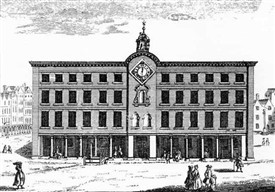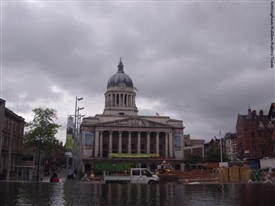Nottingham's Old Market Square

The Exchange in the mid-18th century.
The Paul Nix Collection

Nottingham's Old Market Square and Council House in 2011
Joe Earp
By Joseph Earp
It has always been reputed that Nottingham’s Old Market Square is the largest public space in the UK after London’s Trafalgar Square. The square has long been at the centre of Nottingham life.
Nottingham’s Old Market Square was not the site of the original weekday market for Saxon Nottingham. This was at Weekday Cross but there was often friction when the Norman population from around the Castle had to come into the Saxon town. William Peveril, builder of Nottingham Castle, founded a new market on neutral ground for the two boroughs, now known as the Old Market Square. It was a large market of five and a half acres, functioning from the 11th century until 1928.
When the square was first created a wall was built across the market, running east to west, dividing the animal market from the grain and commercial market. It has long been speculated that the wall was built to separate the two peoples of the Town, the English (Anglo-Saxons) and the French (the Normans). The old positioning of this historic wall was reinstated when the square was redesigned in the 2000s, with a stainless steel drainage channel down the centre of the Square.
J Holland Walker (1931) describes the original layout of the early market: “in the beginning, the whole of the area from High Street to Chapel Bar would be an open space. At the High Street end upon market days would be erected the shambles or stalls upon which the country butchers and the town butchers would display their meat, and this very word shambles gives us a confirmatory date for the establishment of the market, for it was a word, used by Normans for the tradesmen whom our Saxon ancestors spoke of as Flesh Hewers and whose name, as we have seen, has come down to us in a modified form in the name of Fletcher Gate. At first these stalls would be temporary and removable and would be cleared away at the conclusion of each weekly market, but by degrees they became permanent structures though at what date this change took place it is very difficult to say”.
One of the first mentions of the market come in the reign of Henry II (1154-1189), who in a charter granted to the town of Nottingham says “moreover the men of Nottinghamshire and Derbyshire ought to go to the borough of Nottingham on Friday and Saturday with their wains and packhorses.” This seems to visualise a market which would start at sunset on Friday and would not terminate until sunset on Saturday, and the reason that the Derbyshire men were called to Nottingham market is probably because in early days Nottinghamshire and Derbyshire were under one sheriff and were so intimately associated in their government that they had but one prison which was on the site of the old Shire Hall in High Pavement, now the Galleries of Justice Museum.
In 1654 John Evelyn, in the course of an extended tour through England, visited Nottingham, and he describes it as possessing “an ample Market Place with an open sough and pond in the centre, a mouldering stone wall down its midst, trees, saw-pits, stocks, pillory and ducking stool”. J Holland Walker (1931) desribibes Evelyn’s description as extremely interesting and illuminating. He goes on to state that “it presents to us the picture of a typical open country market such as may even to-day be found in certain small out-of-the-way towns of our country, and before we consider the Market Place in detail let us try to elaborate Evelyn’s description. We know that the slope from Long Row to South Parade was broken by a bank and that the sandy soil near this bank was spoken of as “The Sands,” and was used as a horse market for the soft soil would be excellent for trying horses. The horse pond which Evelyn mentions disappeared at an early date, but it would be very convenient for ducking scolds by means of a ducking stool if for nothing else. The sough or drain in front of the Long Row was not filled in until 1826 and the soil for filling this hole was fetched all the way from the top of Mansfield Road near St. Andrew’s Church”.
Between 1724 and 1726 the building known as the ‘Exchange’ was erected. The ‘Exchange’ was completed in 1726 but, by 1815, it needed considerable repair and remodelling. The Exchange building was not originally built to act as the meeting place of the Corporation of Nottingham. The Corporation met in the original Guildhall that stood where the Nottingham Contemporary now stands at Weekday Cross. In 1877 the Corporation moved to temporary premises whilst the Exchange was converted to use for meetings. In 1879 the Corporation met in the Exchange for the first time ~ thus making the Council House site the ceremonial headquarters of Nottingham’s civic government.
Eventually the Corporation needed a new ‘corporate’ building’. During 1926 the old Exchange building was demolished. The modern Council House building we see today would replace it. The Council House was designed by Thomas Cecil Howitt and built between 1927 and 1929 in the Neo-Baroque style characterised by the huge pillars that circle the building along with the carvings on the facade. It replaced the former Nottingham Exchange.
Historically the Square has always formed a meeting place for the people of Nottingham and it has always been the location for local events, civic protests, royal visits, celebrations, and public mourning. A number of Nottingham’s defining moments have taken place in the Square over the last 1000 years.